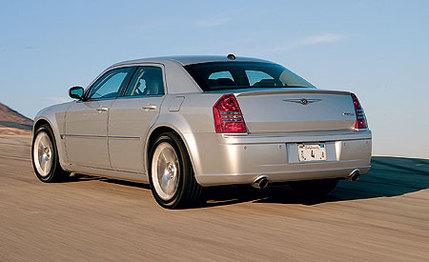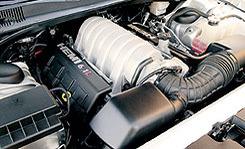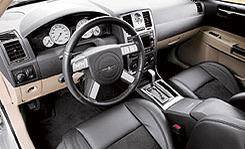
 First Drive Review
First Drive Review
If your mind grinds gears like ours, you've been counting the minutes since the Chrysler 300C Hemi went on sale last spring, wondering what the hot-rod SRT-8 version would be like when it finally went on sale. How much horsepower would it have? What (gulp!) would it cost?
Brace for a trio of startling numbers: 6.1, 425, and $39,995.
That, in order, is the liter displacement of the SRT-8's enlarged Hemi V-8, the horsepower it cranks at 6200 rpm, and the base price (without the as-yet-undetermined gas-guzzler tax). Nice numbers, don't you think? That last one will undercut the 400-hp Cadillac CTS- V by $8000 or $9000, depending on the slurp tax.
Brace for one potentially bad figure: 10,000. That's the number of SRT-8s Chrysler plans to build per year. So expect long lines.
Recent history shows that when Chrysler's Street and Racing Technology group rises to speak, it's worth paying attention. Detroit's foremost speed SWAT team coalesced in 2002 from a group of handpicked motorheads to develop SRT derivatives of new Chrysler and Dodge models. The Neon-based 230-hp SRT-4, the 500-hp Ram SRT-10, and the 330-hp Crossfire SRT-6 joined the catalog in quick succession. Later this year Jeep will get an SRT Grand Cherokee with the bigger Hemi. Except for AMG in Germany, no other factory high-performance group is serving up more muscle or as broad a lineup of vehicles.
The confidence and esprit de corps of the SRT engineers are palpable. Current director Dan Knott maintains regular radio contact with Chrysler CEO and president Dieter Zetsche, who has DaimlerChrysler chairman Jürgen Schrempp on his speed dial. The decisions happen fast so SRT can have its performance derivatives on the street within 18 months of the base-model launch. When it was the 300's turn, these people made some laudable decisions.


As with a teenager's rat rod, most of the SRT-8's money is in the motor. It's a new version of the Hemi V-8, punched out to 6.1 liters from 5.7 and nostalgically sprayed Hemi orange. There's more to this engine than just another 3.5 millimeters of bore. The iron block is a unique casting with revised water jackets and better breathing between the cylinder bays to cut pumping losses. The 5.7's cast crank becomes forged in the 6.1 for more strength. Lighter pistons and reinforced rods add high-rpm durability. A continuous spritz from a bank of oil jets keeps the pistons cooler (synthetic oil only, thank you). Machining of the bores at DaimlerChrysler's plant in Saltillo, Mexico, is done slowly, NASCAR-style, with bolt-on head plates that sharpen the final tolerances.
Up top sit two new cast-aluminum heads. The intake valves grow by two millimeters and get hollow stems to cut mass and thus reduce inertia closer to the 6400-rpm spark cutoff. Sodium fills the oversize exhaust valves to dispel heat. Cylinder deactivation, standard on the 5.7, was left off the 6.1 because it didn't work with the lumpy cam profiles. Hence, the impending gas-guzzler tax.


Slim budgets didn't allow tooling up a new composite dual-stage intake manifold that would have fattened the low- and midrange torque, so engineers went for a max-horsepower setup. A tubular aluminum intake, cast with fine-grain sand to give an almost polished interior surface without an actual polish, sends air plunging down pole-straight rams at the intake valves. Tubular headers sheathed in a stamped-steel heat barrier flow the gas out.
The SRT-8 feels and sounds like a four-door Corvette as it lays rubber through reinforced driveshafts. Peak torque happens at 4800 rpm, so the engine definitely needs to be spun for the full slingshot effect. The Mercedes-designed five-speed automatic, the only transmission offered, stayed mostly in third charging up the hills north of Los Angeles. Knott says the 0-to-60 task should happen in the low fives. Very low, we think.
Glinting from within the 9.0-by-20-inch forged aluminum wheels are four-piston Brembo calipers clamping 14.2-inch front and 13.8-inch rear discs riding on special forged knuckles. Bilstein shocks go in front, Sachs Nivomat shocks in back. Firmer springs and anti-roll bars fill out the handling package but, thankfully, don't chatter teeth on the highway. Tire choices are two: Goodyear Eagle F1 Supercar summer or all-season Goodyear Eagle RS-As.
Rolling on summer rubber, the SRT-8 drifted with surprising nimbleness from corner to kink to straightaway at the Mojave's Willow Springs International Raceway. The stability-control thresholds have been nicely elevated, the computer programmed to spend more time turned off. Roll is tightly restrained. Understeer? Only if you fear the gas pedal.
Exterior tinsel was kept to a minimum. Besides the wheels, the chin receives an air splitter and the tail a small spoiler. Inside: Ritzy chrome bezels accent the doors and leather-wrapped steering wheel, and the gauges get an SRT script as do the embroidered front seats.
"We went for the James Bond approach to performance," said Knott. "You pull up next to somebody at the light, and you know you have the confidence to blow his doors off, even if he doesn't recognize you."
Need more bling? Talk to the aftermarket. At the SEMA show last November, there were at least 90 Chrysler 300s on display, a dog's breakfast of styling baubles.
Need more power? Perhaps you should see a therapist.